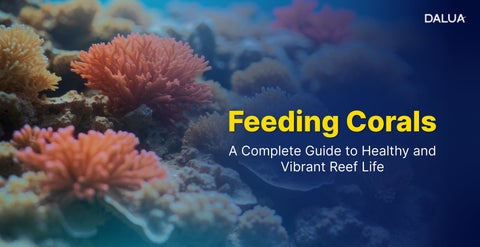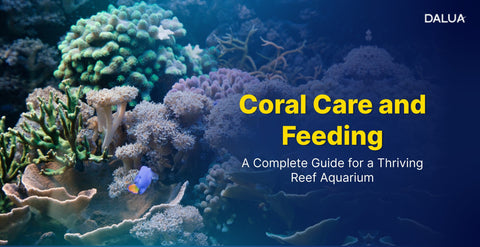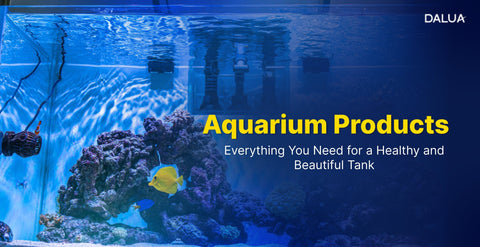Aquarium Pumps: The Heartbeat of a Healthy Tank
When it comes to building a thriving aquarium, most people think about colorful fish, beautiful corals, or eye-catching aquascapes. But there’s one piece of equipment that works quietly behind the scenes to keep everything running smoothly: the aquarium pump.
Whether you have a freshwater setup or a complex saltwater reef system, pumps are essential for maintaining water movement, oxygen levels, and overall tank health. At Dalua International LLC, we know how critical the right pump is for your aquarium’s success. This guide will walk you through why aquarium pumps matter, the different types available, and how to choose the best one for your tank.
Why Aquarium Pumps Are So Important
In nature, water is constantly moving due to currents, tides, and waves. This movement provides oxygen, distributes nutrients, and removes waste. In a closed aquarium system, pumps take on this role.
Here’s why every tank needs a reliable pump:
- Oxygenation: Pumps help circulate water, ensuring fish and corals get the oxygen they need.
- Waste Removal: Continuous flow keeps debris suspended so filters can remove it effectively.
- Nutrient Distribution: Corals and plants rely on moving water to deliver food and trace elements.
- Stable Environment: Prevents stagnant areas where harmful bacteria and algae can grow.
Simply put, a pump is like the heartbeat of your aquarium without it, your aquatic life can’t thrive.
Types of Aquarium Pumps
There isn’t a one-size-fits-all solution when it comes to pumps. The type you choose depends on your tank’s size, inhabitants, and setup. Here are the most common types:
1. Circulation Pumps (Wave Makers)
These pumps mimic natural ocean currents, making them ideal for saltwater aquariums and reef tanks. They promote coral growth and create dynamic water movement.
Best for:
- Coral reefs
- Large saltwater tanks
- Fish that enjoy strong currents
Pro Tip: Place multiple circulation pumps at different angles to eliminate dead spots.
2. Return Pumps
Return pumps are used in setups with a sump system. They move water from the sump back into the main display tank after filtration.
Why they’re essential:
- Keeps water flowing through filtration equipment
- Supports mechanical, biological, and chemical filtration
- Helps maintain a stable water cycle
Choose a return pump powerful enough to turn over your tank’s volume at least 5–10 times per hour.
3. Air Pumps
Air pumps are common in smaller freshwater tanks. They work by pushing air through tubes and diffusers, creating bubbles that improve oxygen levels and add aesthetic movement to the tank.
Best for:
- Small freshwater aquariums
- Quarantine tanks
- Breeding setups
While they don’t move water as much as circulation or return pumps, they’re excellent for boosting oxygen.
4. Utility Pumps
These versatile pumps are handy for water changes, cleaning, or setting up a new tank. They make transferring water easy and reduce the mess during maintenance.
How to Choose the Right Aquarium Pump
With so many options, picking the perfect pump can feel overwhelming. Here’s what to consider:
1. Tank Size and Volume
Larger tanks require more powerful pumps to keep water moving effectively. A good rule of thumb:
- Freshwater tanks: 5–8 turnovers per hour
- Saltwater reef tanks: 10–20 turnovers per hour
2. Type of Aquarium
- Freshwater tanks usually need moderate flow.
- Saltwater reef tanks thrive with stronger, dynamic currents to mimic natural ocean movement.
3. Noise Level
Since pumps run 24/7, choose one that operates quietly, especially if your aquarium is in a living room or office.
4. Energy Efficiency
High-efficiency pumps may cost more upfront but save you money on electricity over time.
5. Build Quality and Reliability
Look for pumps made from durable, corrosion-resistant materials. At Dalua International LLC, we offer premium pumps designed to last, even in saltwater environments.
Tips for Pump Maintenance
A great pump won’t stay great without proper care. Regular maintenance helps extend its lifespan and keeps your tank healthy.
- Clean the impeller and housing every few weeks to prevent buildup.
- Inspect tubing and connections for wear or leaks.
- Check performance regularly to ensure consistent flow.
- Replace worn parts before they fail to avoid unexpected downtime.
Why Choose Dalua International LLC Pumps
At Dalua International LLC, we’re passionate about creating reliable, efficient equipment for hobbyists and professionals alike. Our pumps are designed with precision engineering to deliver consistent performance, quiet operation, and long-term durability.
Whether you need a powerful return pump for your reef system or a circulation pump to keep corals happy, we’ve got you covered. Our goal is to help you focus on enjoying your aquarium—not worrying about equipment failures.
Final Thoughts
An aquarium pump might not be the most glamorous piece of gear, but it’s one of the most important. It keeps your water moving, your fish breathing, and your corals thriving. By choosing the right pump and maintaining it well, you set the foundation for a beautiful, healthy aquarium.
When you’re ready to invest in top-quality pumps, Dalua International LLC is here to provide solutions you can trust. With the right pump powering your tank, you’ll spend less time troubleshooting and more time enjoying your vibrant underwater world.





